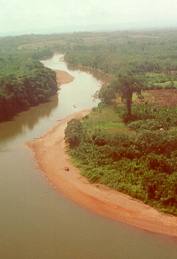

It is the mightiest of the world's great rivers: the Amazon. Draining an area equivalent to more than two thirds of the continental United States, it pours into the Atlantic Ocean about one-fifth of the freshwater that flows into all the world's oceans, a volume so prodigious that it alters ocean salt levels 200 miles from its mouth.
And yet, contends Dr. Jeffrey Richey, a chemical oceanographer at the University of Washington, most of us misperceive the physical nature of a mighty river like the Amazon. "Usually, big rivers are thought of as just pipes from the land to the ocean," he says. "Nobody thinks much about what goes on inside of one."
With funding from several NSF programs, Richey, his graduate students, and South American scientists and their students have been engaged for two decades in a long term, large-scale biogeochemistry project aimed at finding out, in great detail, what goes on inside the Amazon -- most especially its ever-changing chemistry, its interactions with the surrounding riparian (near-shore) area, its flood plain, and even its interactions with the atmosphere.

According to Richey, there is nothing particularly novel in scientists conducting a study of an entire catchment area (a body of water and its drainage basin). However, it is a daunting task to attempt to collect and analyze all the important data -- precipitation, fluctuations in water level, the flow of nutrients and other critical elements. So, for purely practical reasons, most catchment studies have focused on small areas, a tiny creek, perhaps, or a pond. The Amazon study on the other hand, focuses on characterizing the largest river system on the planet, and therefore demands an enormous commitment of time and resources.
"To get that proverbial 'bucket of water' out of the Amazon's main stem is not a trivial task," says Richey. "Instead of putting on hip boots, you have to get on big boats."
Indeed, the 13 research voyages Richey and his colleagues have taken on the Amazon since 1982 have involved the use of an Amazon riverboat equipped much like a sea-going oceanographic vessel. A large part of the basic science conducted from onboard that vessel to date has focused on analyzing the processing, flow, and cycling of important biologically active elements, including carbon, nitrogen, phosphorus, and oxygen, along 2000 kilometers of the river's main stem and major tributaries. These detailed data will serve an especially important role in the future, as a baseline against which scientists can measure ecological change as it occurs in the vast Amazon basin.
The Amazon basin remains one of the most ecologically pristine in the world, but like other major river basins before it, it is undergoing rapid change as populations explode in the region. The baseline data will help answer questions such as: what might be the effects of deforestation, or increased agriculture, on the chemistry and ecology of the vast river. Further, studies built on this foundation of data should be able to provide vital information to policy makers, such as how much of the riverside forest should be protected to control the flow of excess nutrients and sediments into the river, and prevent far-reaching ecological damage?
At the same time, the study is accumulating information critical for understanding phenomena far beyond the Amazon. For example, the periodically wet floodplain bordering the Amazon's main stem produces an estimated five to ten percent of the total global flux of methane gas from wetlands into the atmosphere. Along with carbon dioxide, methane is a key "greenhouse gas," and thus plays a role in trapping heat radiation from the earth. Thus, understanding methane-producing processes in the Amazon floodplain is an important piece in the puzzle of the future of the earth's climate.
Richey also emphasizes the importance of the Amazon project in training the "scientists of the future," both from the U.S. and South America. He adds that the basic "how to" knowledge gained from figuring out how to study the immense catchment area has its own value. It has allowed scientists to transfer the techniques they've learned on the Amazon to a more recent effort to characterize the Mekong River system in Southeast Asia, as well as Puget Sound in the Pacific Northwest.
In the latest phase of the project, Richey has joined Dr. Jorge Quintanilla, of the Universidad Mayor de San Andres, of La Paz, Bolivia, and Dr. Carlos Llerena, of the Universidad Nacional Agraria La Molina, in Lima, Peru, to extend the biogeochemistry study of the river to its little studied upper reaches in Bolivia and Peru. Data collected from this upper region will be integrated with data collected during the many years of study of the Brazilian region.
"So many of the world's big rivers have been manipulated by human activities that they bear no resemblance to a natural river anymore," says Richey. "Think of the Mississippi, or the Danube." But that, he continues, is not true of the Amazon, at least not yet, and that amounts to a big plus for science.
"We very much regard the Amazon as a big natural laboratory," he concludes.




